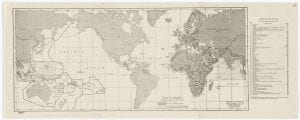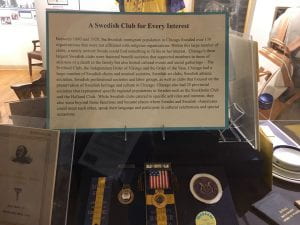Exploration of Andersonville, a Congregation of Swedish immigrants — Comparison of Chinese and Swedish Immigration
Author: Yongfei Lu
Program of Study: Master in Computational Social Science, Division of the Social Sciences (SSD)
On the morning of September 7th, I took a bus with my teammate from Hyde Park to Andersonville. It was a sunny day. On the way to our destination, we passed by long tracks along the Michigan Lake. People were running or cycling in the lanes. Outside of those were golden beaches stretching away to meet the blue lake water. Some were even playing baseball there. That is a typical weekend of American people. No wonder people from all over the world are flooding into this God blessed land. When we were already deep into the Edgewater area, we took a small walk around some blocks and happened to meet local residents holding a yard sale. A placard caught our eyes, printed with the slogan in iridescent color “Here We Believe Love is Love No human is illegal Black lives Matter Science is Real Women’s Rights are Human Rights Water is Life Kindness is Everything”. I started to feel how the place had become the congregation of early Swedish immigrants. Finally, we arrived at the Swedish American Museum and stepped into the history of Swedish immigration. I felt that the questions lingering in my mind these days would be answered, like why the immigration took place, how these foreigners got organized and became united as a community, and whether there is any difference between them and the Chinese immigrants…
Causes of Immigration
Most immigrants harbor an American Dream defined as bettering one’s status relevant to that of one’s parents, or at least maintaining the family status. In the late 19th century, the Swedish ticket agents for travel companies sold the idea that immigrants could find a better life in America. Meanwhile, Chinese immigrants came here for a promising future. Complete preservation of personal property rights, more freedom for each individual’s innovation, and sufficient space for upward social mobility constitute the motivational power that constantly drives American society upgrade.
In the 1880s, overpopulation, lack of arable land combined with unfavorable weather like drought and frost, worried the Swedish people greatly. Threatened by potential famine and economic crisis, some left their country in search of land and work opportunities.
When the early emigrants were seeking arable lands, the United States stood out as their first choice since the Homestead Act of 1862 provided people who resided on the western frontier with inexpensive land. Moreover, the emerging industrial cities in America, like Chicago and New York, demanded huge amounts of labor, which gave them more work opportunities. Most importantly, technological improvements in ocean liners and reduced voyage cost made it possible to bring large numbers of emigrants to their destinations in a shorter time. As a result, with the help of their early-arrived relatives and Swedish travel agents, an average of over 30,000 Swedish emigrants came to America each year from 1880 to 1890.
Immigration Regulations

Figure 3: Maps of immigration quotas from President Franklin D. Roosevelt’s proclamation
From National Archives. (Source: https://www.docsteach.org/activities/student/us-immigration-quotas)
1924 became a turning point when the immigration fever gradually went down. The Immigration Act of 1924 aimed to impede undesirable immigrants, setting up the quota that only 2 percent of the nationality living in the U.S. in 1890 were allowed for entry. Consequently, while Asian countries like China could send only 100 people each year to America, many European countries like Sweden could send several thousand people there, as revealed by the National Archives.
Why is there such a tremendous gap? What made Chinese immigrants undesirable? The Chinese Exclusion can be traced all the way back to the California Gold Rush from 1848 to 1855. As gold became harder to find, Chinese gold diggers were expelled from mining and limited to poorly-paid jobs. Even worse, the economic depression after the Civil War aggravated the animosity towards Chinese immigrants because they lowered the average wages in the industry. As a result, a series of laws, including the 1924 Johnson-Reed Act, were passed to impede the Chinese immigration. In contrast, starting the immigration much earlier, Swedish immigrants had already grown into large numbers. Therefore, even under the strict regulation, the Swedish people can still send over 3,000 immigrants to America each year.
Career Paths
Discrimination can be witnessed by different career paths. Generally, the Swedish immigrants were more skilled and privileged by immigration laws than Chinese immigrants, thus enjoying higher social status. They obtained generous offers from the 1862 Homestead Act, which gave them lands in Western areas for negligible fee. While their Chinese counterparts could only work as coolies in harsh working conditions due to unfair legislation based on races, the Swedish immigrants mastering engineering skills could find decent jobs more easily. In particular, the Great Fire of Chicago in 1871 made these highly skilled Swedish immigrants even more valuable workers. They helped design and build some of Chicago’s most prominent landmarks— including Wrigley Building, Edgewater Beach Hotel and the Apollo Theatre.
As for females, there also existed a huge gap. Female Chinese immigrants were almost invisible (by 1890 only 4.8% percent of the Chinese immigrants) due to exorbitant voyage cost, lack of work opportunities, harsh working conditions, female traditional obligation of caring the internal family affairs, and discriminative judicial treatment. However, female Swedish immigrants enjoyed more freedom and had more work opportunities in cities like Chicago, where they usually received higher salary than in other cities. American Society gave a warm welcome to these Scandinavian maids; literature depicted their “tragic image of pioneer immigrant wife and mother”; their American employers also treated them with a courtesy. In conclusion, Swedish immigrants were widely regarded as the best immigrants. Quoting the statement of the Congregational missionary M. W. Montgomery, “they were more like Americans than are any other foreign peoples.”
How They Unite
Another interesting aspect is that Swedish immigrants had maintained great cohesion throughout the immigration. In general, they relied on two mechanisms— Swedish churches and secular social activities. Unlike Chinese immigrants, who worked hard and tended to relax only on special festivals, Swedish immigrants organized a wide variety of activities and clubs among which every individual could find one fitting their interests after work. During the immigrant population surge, Swedish clubs started to be open to the working class. Immigrant aid societies, along with sick- and death-benefit societies were founded to help those in trouble. Even today, the extant clubs serve as a place for those Swedish Americans of American birth, who tend to know little about their original cultures, to rediscover their roots. Apart from these, churches also worked as focal points for the Swedish community, maintaining their ethnic ties and cultural heritage. Ebenezer Lutheran Church was established as a congregation of the Augustana Lutheran Synod, where even today Swedish Americans hold important social events.
However, the Chinese immigrants didn’t have such a strong religious or club membership bond. In many cases, Chinese immigrants built the Associations for the sake of survival, fighting against universal discrimination and unfair treatment. Interestingly, inside the community existed a distinct divide– a minority of lower-class immigrants formed tongs to glean profits from lucrative criminal activities, including gambling and prostitution.
From the analysis above, we can see how the Swedish immigration path differs from the Chinese one. Different treatment as they received in the history, they both harbor an American Dream that has been encouraging them to strive for a niche where they can develop their potential, fulfill their ambitions and eventually lead a better life. As international students nowadays in America, we don’t need to cope with many of the hardships our pioneers experienced in the past, but we do have our own problems and challenges. So what specifically is our American Dreams that can drive us to carve out our own way to fulfillment.
Citation
1. Adams, James Truslow. The Epic of America. New Brunswick, N.J.: Transaction Publishers, 2012.
2.Brattne, Berit, and Sune Åkerman. The Importance of the Transport Sector for Mass Emigrationin Runblom and Norman, From Sweden to America, 1976.
3.Bernfeld, Beatrice. Asian Pacific Americans-enriching the evolving American culture. 2006.
4.Homestead Act: Primary Documents in American History. https://www.loc.gov/rr/program/bib/ourdocs/homestead.html
5.Barton, H. Arnold (Hildor Arnold). A Folk Divided: Homeland Swedes and Swedish Americans, 1840-1940. Carbondale: Southern Illinois University Press, 1994.



Leave a Reply
You must be logged in to post a comment.